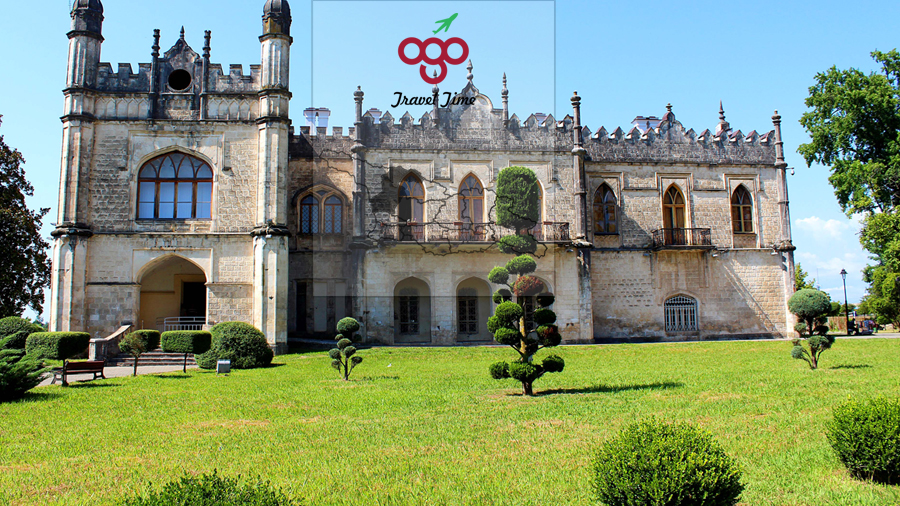
Samegrelo
Tropical summers, mild winters, exotic fruits, hot spicy dishes and unforgettable hosts – Samegrelo is a hard place to leave, located among the ravines created by the Rioni, Enguri and Tskhenistskali rivers and the Black Sea. Also known as Mingrelia or Mengrelia, this western region is kept warm and humid by the Black Sea, and is home to the Megrelians, a distinctive sub-group of Georgians who have their own language. The north side of Samegrelo is landlocked by the region of Svaneti and the Caucasus Mountains. The region’s administrative centre is Zugdidi
ADVENTURE
Caving, canyoning, kayaking, trekking, biking, bird watching and boating are all activities that can be enjoyed while visiting the Samegrelo region. Marked trails near the Martvili monastery allow you to enjoy the canyons of Balda, Gachedili gorge and the Motena and Toba caves, cascade waterfall. In the Kolkheti National Park visitors can also join in a variety of wildlife tours.
THE MYTHICAL LAND
Travelling through this region you’ll find not only rich Georgian culture, but also the Greek legend of the mythical King Aeetes – the son of the Sun God Helios, who ruled the Kingdom of Colchis. The pre-Christian Kingdom of Colchis was the first Georgian state mentioned in Greek history and mythology, as the country where the Argonauts came to find the Golden Fleece.
The region’s unique identity is its cuisine, and everyone should taste Megrelian food at least once in their lifetime. Ranging from the spicy to the exotic, visitors will discover many mouthwatering dishes. The Megrelian kitchen uses local varieties of cheese and vegetables in its regional dishes and admirers of spicy food and sauces will find this cuisine an undeniable hidden treasure. Visitors can expect a warm and welcoming atmosphere at local restaurants and family owned guesthouses.
The National Park is located in Western Georgia. It covers the eastern zone of the Black Sea coast and the basin of the Paliastomi Lake. The park was established to protect and ensure the survival of the wetland ecosystem. The Kolkheti National Park and Paliastomi Lake are famous throughout the Caucasus for their abundant birdlife and unique scenery.
The mineral water of Lugela comes from the gorge of the Khobistskali River, located in the upper part of the Samegrelo range. The famous resort of Mukhuri is situated 4 kilometres from Lugela. The water here is clear with a naturally high mineral content, and has a unique property that this water does not freeze – even at -25 °C.
With a season lasting from June to October, Lebarde is a thermal spa resort located on the Egrisi mountain range at 1,600 metres above sea level. Winters are mild and summers are quite cool with an average temperature of around 16°C in August. The mountain air and health restoring properties of the mineral waters are good for locals and visitors alike.
Menji, a thermal spa resort in Senaki municipality, is situated in the Tsivi River gorge and has a subtropical climate, with mild snowless winters and warm, humid summers. The resort is open all year round and boasts a special mineral water that is said to help cure many diseases and conditions.
WHAT TO SEE IN SAMEGRELO REGION
Poti, or “Phasis” is mentioned as far back as the 8th Century BC when the ancient Greek historian Strabo wrote: “In Phasis there are people speaking 60 different languages.” Today the city is as lively and busy as it was centuries ago. Thanks to its location on the Silk Road at the crossroads of Asia and Europe, it was one of the world’s busiest ports and the bustling activity in the city has not changed for centuries. It is still the main port and trade centre of Georgia.
Anaklia is a rapidly developing Black Sea resort located in the Zugdidi municipality, where the Enguri River flows into the Black Sea. Many of its sun-worshipping visitors come to see the ruins of the old fortress, which dates back to 1703. Today Anaklia’s beauty attracts much interest from international and local investors.
Samegrelo is rich in karst caves and many of them are located in the Migaria mountain system. They include Zesnakhe, Potoltsvena or “Fall of the Leaves”, and the Velvet Caves which are the most well-known. The caves are a paradise for cave enthusiasts due to the numerous explored and unexplored caverns. The glacier lake Tobavarchkhili (2,643m) is worth a special mention, as it is only possible to reach this glacier lake after a 20km hike from Chkhorotsku.
Nokalakevi, is a truly fascinating place. Literally meaning “the place where a town was”, Nokalakevi was called Tsikhegoji. According to Georgian history, the fortress was built by Kuji – Duke of Egrisi and Svaneti in the 3rd Century BC. It is thought to be the mythological city of Aia, capital of the Kingdom of Colchis, and home of the fabled Golden Fleece. Archaeological excavations have found several different layers of civilization in the Nokalakevi territory. The oldest layer dates back to the 8th-7th century BC. Various valuable items have been unearthed here, including wine vessels, golden, silver, bronze and glass adornments, diverse pottery and ceramic objects. The ruins of ancient palaces, Christian churches, baths, and tunnels have also been identified and preserved.
In the 7th century the monastery named in honour of Saint Andrew was built in the village of Martvili. Its foundation is a huge oak tree that for centuries served as a pagan idol. People used to worship this tree as a God of fertility, fruitfulness and prosperity. In the 1st century one of Christ’s Apostles – Andrew the First called, converted the natives to Christianity who then cut down the oak tree and in its place built a church. The church is cross-domed, and paintings on the walls date back to the 6th and 7th century. A two-storey cathedral was built next to the church in the 10th century. In the Middle Ages the Martvili Monastery was a centre of culture and education, attracting many writers, translators and philosophers.
The Rukhi Castle is located in the village of Rukhi, on the left bank of the Enguri River. It was built in the 17th century by the duke of Samegrelo, Levan Dadiani II, and served as the major fortification for the Dukes of Samegrelo. The castle consists of a citadel and an inner courtyard with two impressive towers.
The Dadiani Palace, located in Zugdidi, belonged to the former Dukes of Samegrelo. In 1921 a museum was founded in the palace housing items and archives of the palace’s rulers. The museum complex consists of the palaces of Ekaterine Chavchavadze-Dadiani and Niko Dadiani (19th century.), a church and a decorative garden laid out by the Dadianis. Niko Dadiani’s palace contains the largest ballroom in all of Georgia and the palace garden is planted with unique trees and bushes from all over the world. In 1850 Prince David Dadiani, opened a museum in the palace. It housed a collection of ancient stone-age items, European military weapons of the Middle Ages, paintings, and fine works of art. Today more than 50,000 rare exhibits are on display at the museum. Among its collection of relics of European monarchs and imperial families there is a death mask of Napoleon Bonaparte. The museum also houses the relics of Christian saints, including the Shroud of St. Mary, which was brought to Georgia in 1453. The protected arm of St. Marine, parts of St. Kvirike, St. George and John the Baptist are also housed here.
The Tsaishi Cathedral Church of St. Mary is administered by the Zugdidi and Tsaishi Eparchy of the Georgian Orthodox Church. The domed church was built in the 12th-14th centuries but was destroyed by an earthquake and rebuilt in the 17th century. The oldest building of the church complex is located outside of the wall and judging by its interior dates back to the 11th century.
The Tsalenjikha Cathedral Church (10th century.) stands on a hill outside Tsalenjikha. A bilingual Greek-Georgian inscription on the South-Western pillar of the church reveals that the interior of the church was frescoed by Cyrus Emanuel Eugenicus, a Byzantine artist from Constantinople. The Megrelian Prince Levan Dadiani II and his wife Nestan-Darejani are buried in the Western area of the church.
The Khobi Church is located 4 kilometres from the city of Khobi, in the village of Nojikhevi. In old times it was called The Khobi Monastery. The Khobi Monastery is an architectural complex consisting of a church, a palace, a bell tower and the ruins of buildings. The stone church tower, with seven windows, is one of the biggest bell towers in Georgia and was once covered in frescoes. Inside its walls stands a 13th century church, decorated with ornaments and frescoes.
The Kortskheli Church stands on a hill eight kilometres North-East of Zugdidi on the road to Tsalenjikha. From there visitors can see the mountains of Svaneti and Abkhazia, Samegrelo, the lowland of Kolkheti, and the Black Sea. According to historical documents, the church was built and frescoed in the 17th century by Levan Dadiani II.
This church was built especially for an icon of the Virgin Mary of Vlakerni. The icon, as well as the waistband of the Virgin Mary, was regarded as the most sacred items of Samegrelo. The icon was taken to Russia and given to Alexander I with the hope that the Emperor would one day return this relic to Georgia. Later, the Emperor did return the icon along with the finances for building a church to Levan Dadiani.
The Guria-Samegrelo eparchy church was established in Poti during the 19th century. The military governor of Kutaisi established a committee for the building of a Cathedral on June 17th 1895 with the permission of the Russian Commander. The church was meant to be built in a Georgian architectural style, but the Russian government rejected this project and the architects Zelenko and Marfeldi had to submit a new design. According to that proposal, it was intended for the church to be a small version of the Hagia Sophia Church in Constantinople with enough room for 2000 parishioners. On the North side of the church icons were made in the Greek-Byzantine style; the South side icons were in a Georgian-Byzantine style, and the central side icons were in a Russian-Byzantine style. Saint Nino and Saint David the Builder were featured amongst these icons. In 1932 the communist governors of Poti turned the church into a theatre. It was given back to the patriarchy in 2005 and it has now returned to its original function.
©Georgian National Tourism Administration
